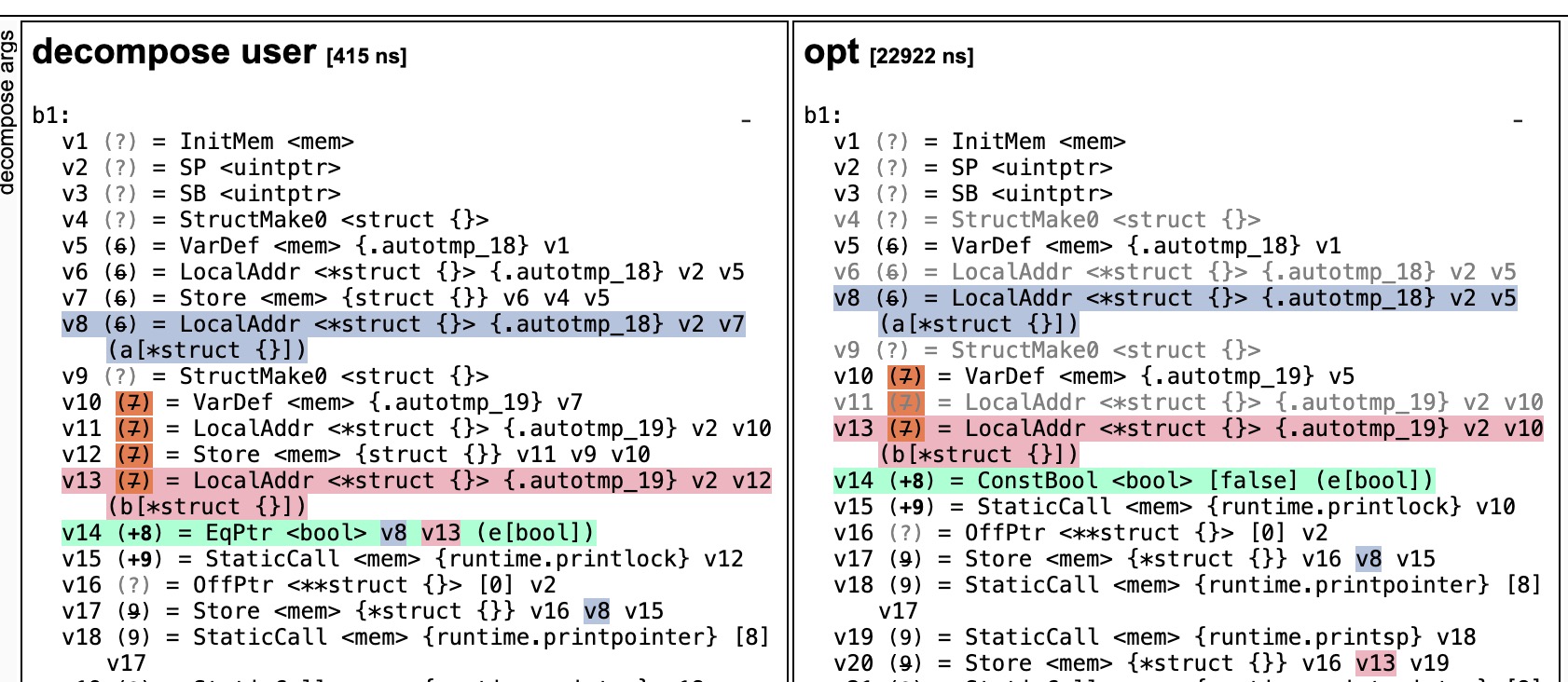https://www.zhihu.com/question/364687707
在知乎上已经说了原因,不过只是讲官方的 spec,我们再来看看实现上具体为什么会是这样的。
package main
import "fmt"
func main() {
a := new(struct{})
b := new(struct{})
println(a, b, a == b)
c := new(struct{})
d := new(struct{})
fmt.Println(c, d, c == d)
}
结果可能让你很惊讶:
0xc00007af1f 0xc00007af1f false
&{} &{} true
如果之前碰到过给程序加上 fmt.Println 就导致结果变化的情况的同学,可能会想到这里的原因,是和逃逸分析相关。(可以参考这两个 issue :8618 和 31317)
没错:
~/test git:master ❯❯❯ cat -n true.go ✱ ◼
1 package main
2
3 import "fmt"
4
5 func main() {
6 a := new(struct{})
7 b := new(struct{})
8 println(a, b, a == b)
9
10 c := new(struct{})
11 d := new(struct{})
12 fmt.Println(c, d, c == d)
13 }
~/test git:master ❯❯❯ go run -gcflags="-m" true.go
# command-line-arguments
./true.go:12:13: inlining call to fmt.Println
./true.go:6:10: main new(struct {}) does not escape
./true.go:7:10: main new(struct {}) does not escape
./true.go:10:10: new(struct {}) escapes to heap
./true.go:11:10: new(struct {}) escapes to heap
./true.go:12:13: c escapes to heap
./true.go:12:13: d escapes to heap
./true.go:12:22: c == d escapes to heap
./true.go:12:13: main []interface {} literal does not escape
./true.go:12:13: io.Writer(os.Stdout) escapes to heap
<autogenerated>:1: (*File).close .this does not escape
0xc00007af1f 0xc00007af1f false
&{} &{} true
在 fmt.Println 中单独出现了 c,所以 c = new 的时候就发生了逃逸,d 也同理:
- 未逃逸:a,b
- 逃逸:c,d
看过一点 go runtime 代码的同学应该知道,在 runtime 里有这么个东西:
// base address for all 0-byte allocations
var zerobase uintptr
0 大小的内存分配均会指向该变量地址,所谓的 0 字节,主要就是这种空 struct。不过这里没说清楚的是,只有在堆上分配的 0 大小的 struct 才会指向该地址:
package main
import "fmt"
var a = new(struct{}) // 堆上
func main() {
var b = new(struct{})
fmt.Println(b/*这里单独打印了,所以 b escape 到堆上*/, a == b)
}
那么空 struct 逃逸之后其实都是同一个变量,地址相等,我们是可以理解了。
没逃逸的 a 和 b 为什么地址不相等呢?这里可以祭出 SSA 大法:
~/test git:master ❯❯❯ sudo GOSSAFUNC=main go build true.go

可以看到这个 false,其实是在代码优化阶段(opt)直接被编译后端作为常量优化掉了,直接转成了 false。
所以我们本能地以为 == 是在做指针比较,但是常量优化会替我们做出不那么符合直觉的判断,直接把 a == b rewrite 为 false。
问题到这里也就结束了,既然我们知道这里是优化阶段做的,那是不是我们把优化关闭就会导致输出 true 呢?
确实是的:
~/test git:master ❯❯❯ cat true.go
package main
import "fmt"
func main() {
a := new(struct{})
b := new(struct{})
println(a, b, a == b)
c := new(struct{})
d := new(struct{})
fmt.Println(c, d, c == d)
}
~/test git:master ❯❯❯ go run -gcflags="-N -l" true.go
0xc00007aece 0xc00007aece true
&{} &{} true
PS:写这个只是图个乐,我们可以用 Go 附带的 SSA 工具去更深入地认识整个编译阶段干的事情,从而理解官方的所谓“实现细节”和 spec 上的 may or may not 到底是怎么回事。
要是哪位工程师拿这个去做面试题,那就太缺德啦!
